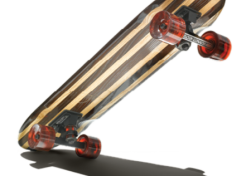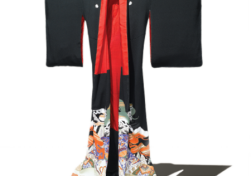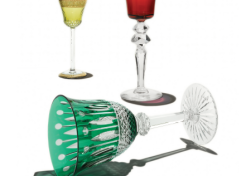Skateboarders and surfers might not immediately strike one as being kin. The former inhabit urban environments, while the latter ride the wild ocean waves. But skateboarding was born out of Californian surfers’ desire to ride a board whatever the weather – by attaching wheels from roller skates to pieces of wood, they could ride year-round – and today the best skateboards are still, like surfboards, hand-crafted from wood. This natural material is partly popular, says Texas-based maker Jake Eshelman, because skaters still take inspiration from 1960s pioneers “who would make boards in their garages, using planks and their dad’s power tools, in a way that was rather beautiful and naive”. Eshelman’s Side Project Skateboards are made from found hardwoods that are not endangered, the most popular being cherry maple and walnut. Some boards, inlaid with strips, might contain up to 35 different pieces, on to which are added American-made ball bearings, Seismic wheels and Chromexcel leather. The end product, he says, “is in a bracket somewhere between functional art and design”. sideprojectskateboards.com
As recently as 80 years ago, the kimono – “something to wear” – was still commonly worn in Japan. An outer garment sported by both men and women, it can be adorned in different ways. Men’s kimonos might be embellished with paintings of great warriors. Women’s are traditionally embroidered and delicately painted with natural scenes and, to reflect the modernization of society in the 20th century, bright graphic prints. Whatever the imagery, a kimono was historically a symbol of power. Today, kimonos are mostly worn for formal occasions, but demand for them endures, with designers such as Anna Sui and Yohji Yamamoto launching contemporary versions as well as kimono-inspired dresses. Ichiroya, a family-run Japanese company which deals in traditional cultural items, says many of its customers buy the jackets to wear with modern dress. In the West, too, the kimono is enjoying a comeback. As kimono dealer Ceri Oldham from Wafuku puts it, “Kimonos are wearable textile art and have an otherworldliness that one finds in no other garment. It is impossible not to feel elegant while wearing one.” ichiroya.com; wafuku.co.uk
Colored wine glasses have a noble history. They were popular with the Romanovs, the French Court and Britain’s Georgian dandies, and now they’re back in vogue. Versace, for example, has brought out wine glasses with arabesque patterns and yellow-tinted glass heads, while the antiques market is aflame with colored glasses from names like Moser, Heckert and Baccarat. Europe’s oldest glass studio, with roots in the 16th century, is the Compagnie des Cristalleries de Saint-Louis in Lorraine, France. “The first colored pieces were created at Saint-Louis in the 19th century,” says Jérôme de Lavergnolle, the glassmaker’s CEO, who describes the creation of a colored crystal glass as “a kind of alchemy”. It should go without saying, but colored wine glasses should be made of colored glass: that is, glass with color contained within its crystal, rather than sprayed on. As M. de Lavergnolle notes, “Each colored crystal glass turns a dinner into a celebration and gives a little extra to the ordinary.” Let’s drink to that. saint-louis.com


